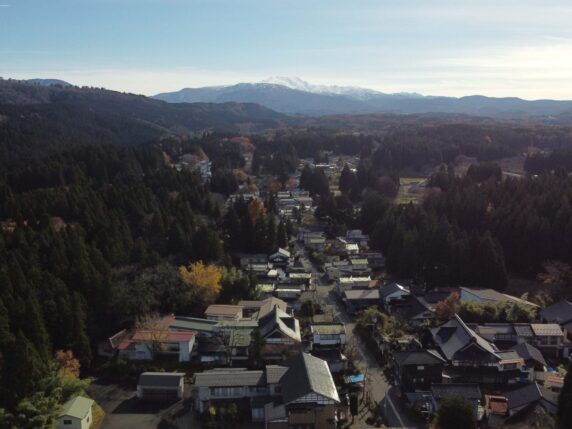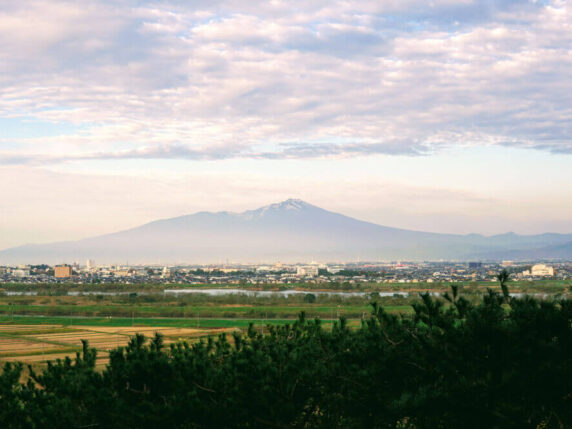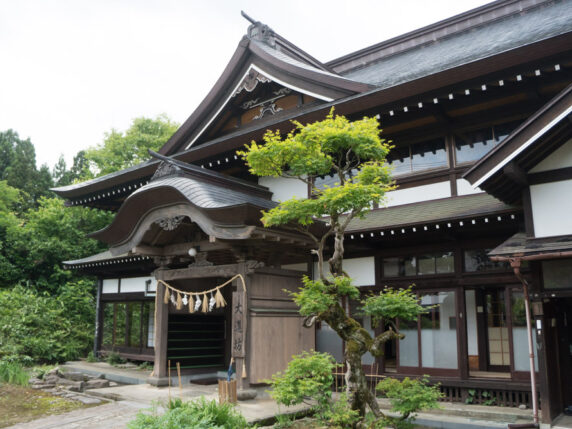Dewa Sanzan Hiking and Itineraries
Written by Timothy Bunting
Why Hike the Dewa Sanzan?
To truly get the most out of a Dewa Sanzan hike, it’s important to understand exactly how the three mountains became a centre for spiritual rebirth in the first place. Since ancient times, the Japanese have regarded mountains as an abode of the gods, a sacred location holding all of life’s secrets. Those brave enough to enter came out feeling totally refreshed, euphoric even. More and more ventured into the mountains, and more and more came out feeling as if they had been ‘reborn’. Before long, the Dewa Sanzan became known as a central location for spiritual rebirth. Looking for Dewa Sanzan itineraries? Skip to the section. Or, go straight to the bus section for public transport options.
READ MORE: Why to add the Dewa Sanzan to your bucket list
Embody the Teachings of Buddha by Hiking the Dewa Sanzan
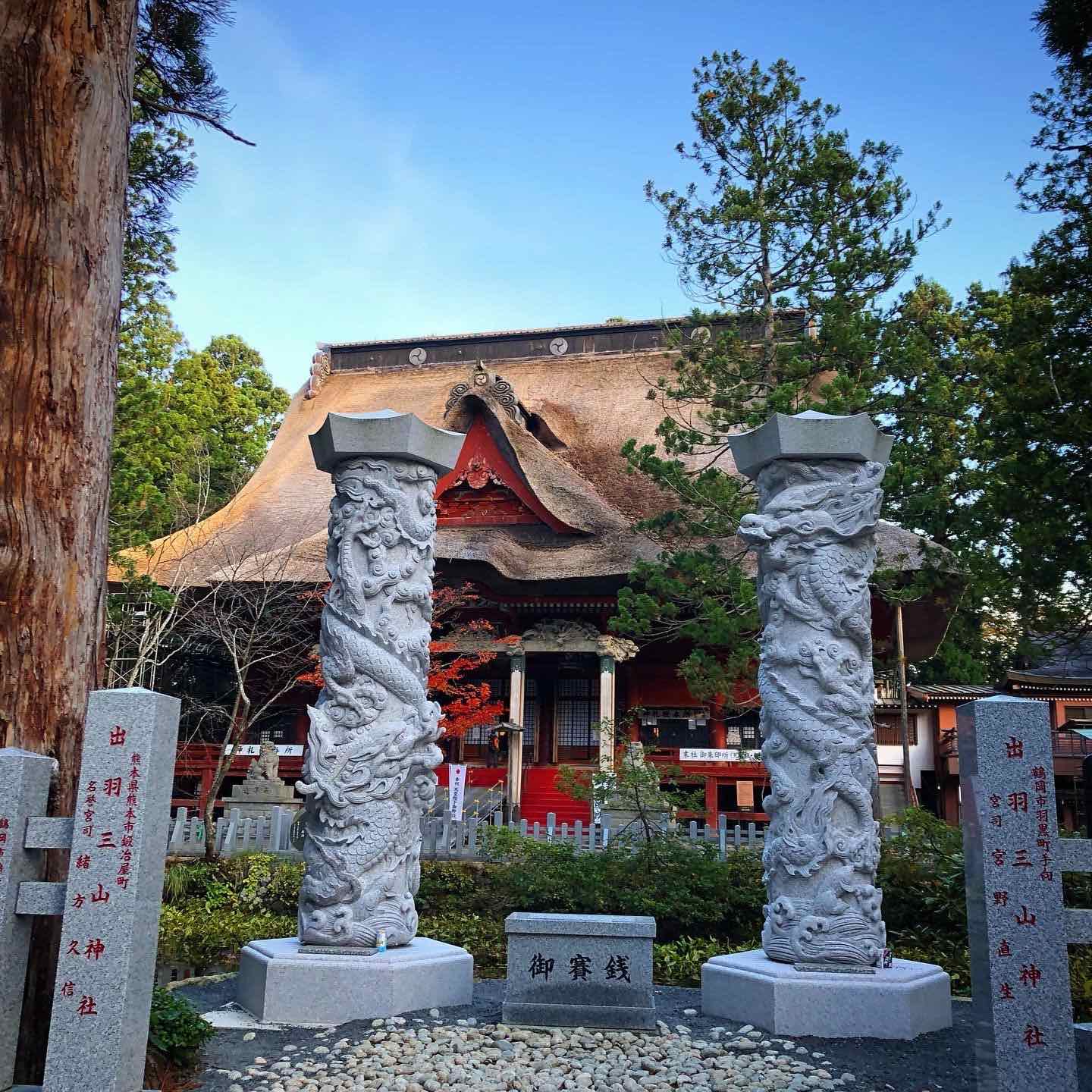
Those who have visited Mt. Koya and the Kumano Kodo, or have done the Shikoku Henro pilgrimage, would have heard of Kukai, posthumously known as Kobo Daishi. Kukai was the monk who brought Shingon Buddhism to these areas in Japan from China in the 9th Century. At the same time, Kukai also brought Shingon Buddhism all the way to the Dewa Sanzan, most notably to Mt. Yudono.
Mt. Gassan had always been animistic and was used by monks from both Mt. Haguro and Mt. Yudono, who both followed Shingon Buddhism until the mid 1600s. In the 1630s, in a move that was most-likely politically motivated, Mt. Haguro switched to Tendai Buddhism. Mt. Yudono remained Shingon at this time following the beliefs of their founder, Kukai. During the Meiji Restoration in 1872, there was a call to abolish Buddhism from Japan, and all three of the Dewa Sanzan forcibly switched to Shintoism. Well, almost. The main object of worship on Mt. Yudono came under the rule of the newly founded Dewa Sanzan Shrine, however Dainichibo and Churenji Temples located on Mt. Yudono stubbornly stayed the Shingon sect of Buddhism, which continues to this day.
Zen Buddhism believes reflecting inwards through Zazen meditation puts one on a path to achieve enlightenment in a future life. In contrast, the Shingon Buddhist sect espouses a completely different belief. Shingon believes enlightenment can be attained in the current world by practicing in, and learning from, nature. In fact the very word Shingon is the Japanese term for Mantra. It is believed that Buddha’s teachings are projected onto the Dewa Sanzan in the form of Mantra. Thereby, walking through the Dewa Sanzan is a way to embody Buddha’s teachings, and attain enlightenment.
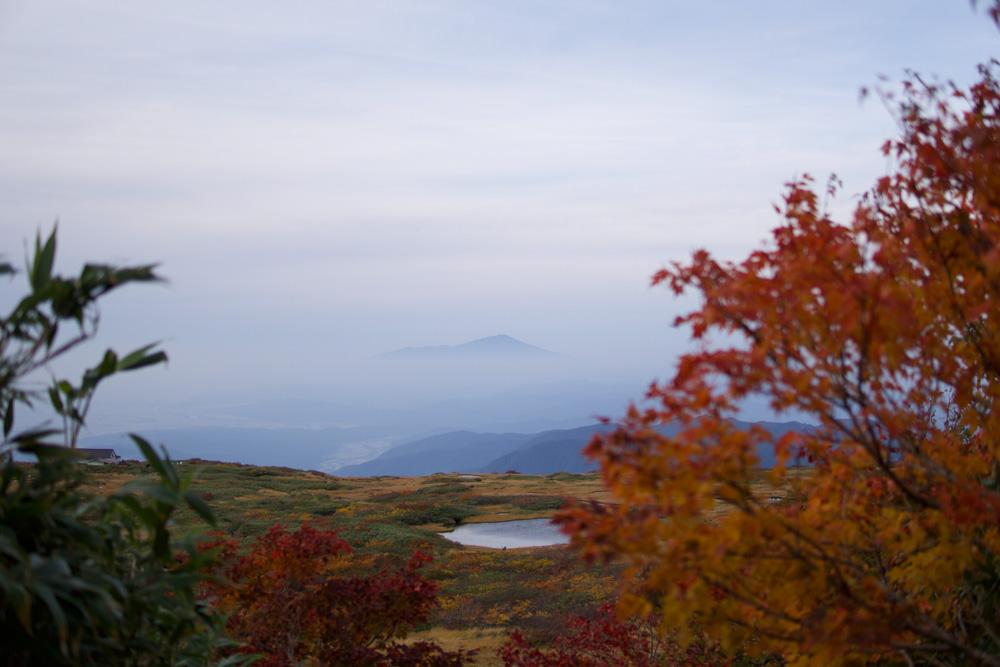
Sokushinbutsu Living Buddha or Buddha Mummies
One stark example of this belief is with the Sokushinbutsu Living Buddha or Buddha Mummies of Mt. Yudono. Sokushinbutsu literally means ‘Buddha in the flesh’. By becoming Sokushinbutsu, the Shingon monks believed they could attain enlightenment, and in the process leave behind a trace of Buddha in the current world. You can actually meet some of the Sokushinbutsu. There are 21 known Sokushinbutsu that remain in Japan, and all of them trained on Mt. Yudono. There are 6 alone in the Shonai region, one in each of Churenji, Dainichibo, Honmyoji, and Nagakuji Temples in Tsuruoka, and two in Kaikoji Temple in Sakata.
By no means am I suggesting you undertake Sokushinbutsu training and become a Living Buddha. I am simply hoping you keep this in mind as you receive the energy from the mountains on a Dewa Sanzan hike. Want to escape it all? Feel the need to get in touch with nature? Why not follow in the footsteps of Matsuo Basho? How about being spiritually reborn? Take a hike on the Dewa Sanzan!
Dewa Sanzan Hike Duration
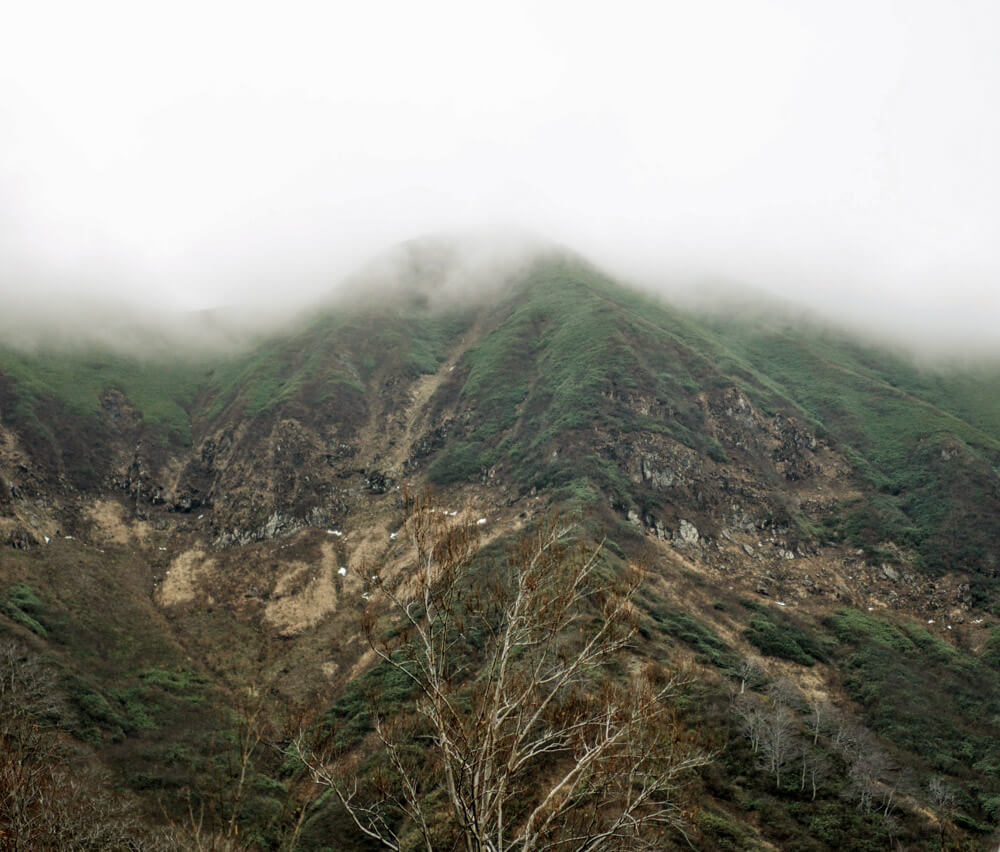
How long should you allow for a Dewa Sanzan Hike? Well, we’d recommend a minimum of two nights and two days to hike the Dewa Sanzan. It would be possible to hike all three of the Dewa Sanzan in one day, however we don't recommend it. First, it's better to take the time to truly appreciate them. Second, you would probably have to climb Mt. Haguro at night, which isn't always a good idea. Third, it would take a bit of planning. The mountains aren't exactly easy to access, and if something goes wrong, you'd be in a pickle.
On that note, there are two important things to keep in mind when it comes to hiking the Dewa Sanzan; the climate, and transport. In this article, I’ll share with you two Dewa Sanzan itineraries that take both of these things into account. After that, I’ll let you decide which option suits your group better.
When Should you Hike the Dewa Sanzan?
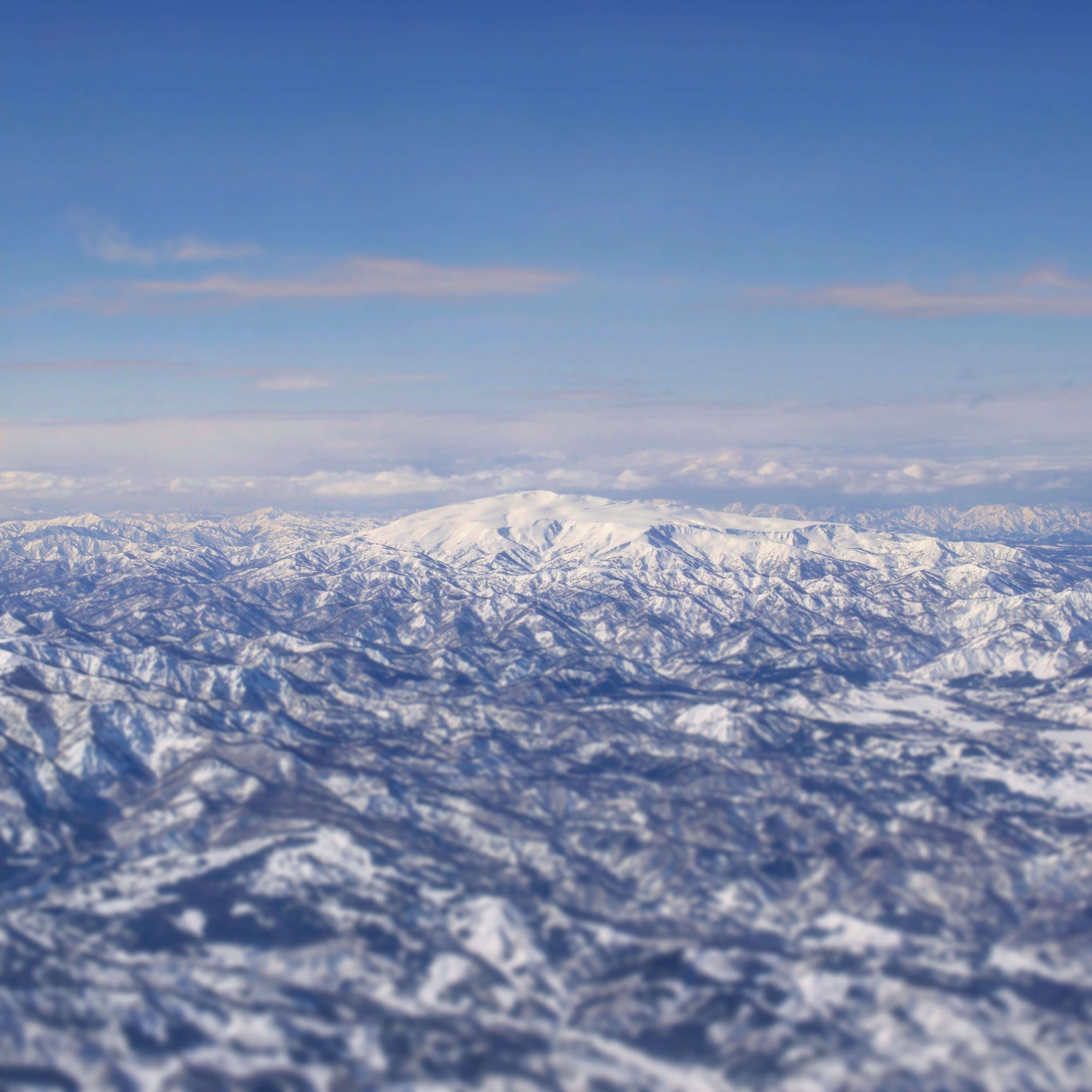
For followers of Haguro Shugendo, snow is such an important part of life. As snow melts, it carries nutrients to the plants we eat for our survival. However, for those looking to hike the Dewa Sanzan, snow can be problematic. The Dewa Sanzan gets so much snow that the 1984m (6509ft.) Mt. Gassan only opens for hiking in July. In fact, with its start in April, Mt. Gassan has the latest ski season of any mountain in Japan. So, exactly when is the best season to hike the Dewa Sanzan?
In short, you want to time your Dewa Sanzan hike with the opening of the mountains. Not only that, if you're using public transport, the bus timetable will also play a large role (see the Dewa Sanzan Busses section below). As Mt. Gassan is only open between July and mid-October, sometime between then is best for climbing all three. July and August is generally hot down below, but can be freezing up at the top of Mt. Gassan. Going up there at this time of year is a great way to escape the heat of summer. September and October are cooler months, and are quite pleasant to hike when the autumn leaves are out. Let’s take a look at what to consider for hiking each of the Dewa Sanzan month by month.
Mt. Gassan Hike Season
The 10m of snow that falls annually on the tallest of the Dewa Sanzan, Mt. Gassan, means that the mountain doesn’t open for hiking until July 1st. The snow begins to fall in mid to late October, and Mt. Gassan shrine officially closes on September 30th. This doesn’t mean you can’t climb the mountain then, however. Both the road to Mt. Gassan’s 8th station and the ski lift is open until the latter half of October. This leaves plenty of time to take in the autumn leaves.
Perhaps the best time to climb Mt. Gassan would be September or even early October when most of the snow on the path has melted and the autumn leaves are making an appearance. In saying that, climbing Mt. Gassan in July and August is an excellent way to escape the summer heat, and take in the atmosphere of the world of the afterlife.
Mt. Yudono Hike Season

At 1504m (4931 ft.), Mt. Yudono gets its fair share of snow. Mt. Yudono Shrine generally opens officially by the start of golden week in early May. Snow starts falling on Mt. Yudono around November, so the shrine officially closes at the end of October. October is usually peak season for the autumn leaves, and all in all is not a bad time to hike the Dewa Sanzan.
It’s important to note that strictly speaking, Mt. Yudono is not a mountain that you hike. It is still possible to climb to the peak of Mt. Yudono, however it isn’t a very popular thing to do. The main feature of Mt. Yudono is Mt. Yudono shrine. From there, people begin the climb up to the top of Mt. Gassan. It’s relatively easy to get to Mt. Yudono shrine by road. There is a ¥400 toll road off route 112 that takes you to a car park. Then, there is a bus to the main shrine that costs ¥300 one-way, or ¥400 return. Alternatively, this route is also quite nice to walk along, weather depending, of course.
Mt. Haguro Hike Season
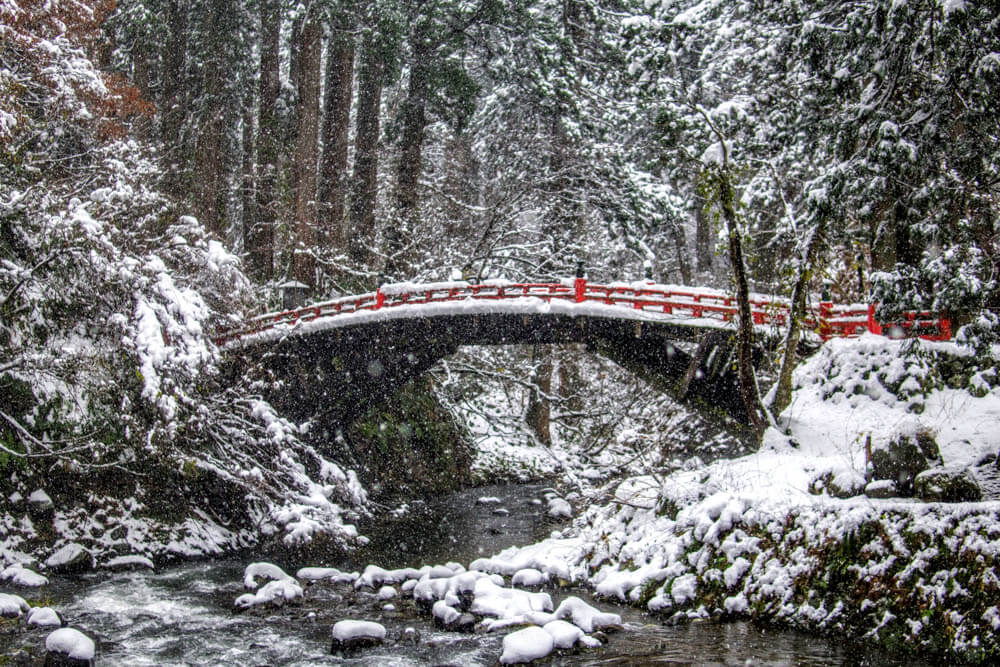
The lowest-lying Dewa Sanzan peak, Mt. Haguro, is the only one open year-round. That is why it is home to Sanjingosaiden, literally the collective shrine for the three gods. When Mt. Gassan and Mt. Yudono close, their gods are transferred to the shrine at the top of Mt. Haguro. They are brought back to their original spots in a ritual in May.
If you’re not worried about hiking all of the Dewa Sanzan, Mt. Haguro alone should be enough. In terms of climate, Mt. Haguro is perhaps best climbed in mid spring to early summer (early May to mid-June) to avoid the heat of summer, or in autumn (September to November). However, the greenery of summer is a pretty big drawcard to Mt. Haguro. In addition, the Dewa Sanzan Flower Festival happens on Mt. Haguro in July, and it’s also the start of the Five Story Pagoda Light up. The Akinomine Autumn Peak Ritual that concludes with the Hassaku Festival is also great to witness.
Moreover, although not strictly hiking, Mt. Haguro can be climbed in winter, with snowshoes of course. Want to check out the Five Story Pagoda covered in snow? Yamabushido offers experiences on Mt. Haguro in the winter months. Alternatively, The Ideha Cultural Memorial Hall at the base of Mt. Haguro rents out snowshoes for those feeling adventurous. It takes 40 minutes from Tsuruoka Station to Mt. Haguro on the bus. The bus costs ¥820 to the base (the Shukubo Pilgrim Lodges, Zuishinmon), or ¥1,180 to the top (Sanjingosaiden, Dewa Sanzan Shrine, Saikan).
Dewa Sanzan Hiking Itineraries
Put simply, whether you have your own transport or not will affect your options for hiking the Dewa Sanzan. You can learn more about how to access the Dewa Sanzan here. In this article I’ll introduce the two main itineraries for visiting Mt. Gassan and Mt. Yudono. Both Dewa Sanzan itineraries assume you stay on or near Mt. Haguro meaning you can easily visit all three of the Dewa Sanzan. Itinerary one takes you on a mountain path from Mt. Gassan to Mt. Yudono. With itinerary two, each mountain is visited separately.
For both Dewa Sanzan itineraries, we recommend staying in a Shukubo Pilgrim Lodge on Mt. Haguro, or at least somewhere nearby. This is because getting from Mt. Haguro to the other two peaks is relatively easy, but the reverse isn’t true. The drive from Mt. Gassan 8th Station to Mt. Yudono takes about two hours and is best avoided. From the Shukubo, it’s possible to walk to the top of Mt. Haguro, and also access busses to and from Mt. Gassan and Mt. Yudono. Private access from here isn’t as bad either; it’s one hour to the 8th station of Mt. Gassan, and about 40 minutes to Mt. Yudono by car. In addition, you won’t have to take all of your luggage with you when you do a big climb.
Mt. Haguro Hike

Depending on the time of day, you might want to climb Mt. Haguro before or after the other two mountains. Altogether, the climb on the stone stairway from the Zuishinmon gates at the base to Sanjingosaiden Shrine at the top takes about one hour one-way. All in all, you want to allow at least three hours to check out Mt. Haguro.
If you have the time, we recommend exploring the top of Mt. Haguro, such as Saikan where you can have Dewa Sanzan Shojin Ryori Ascetic Cuisine, Dewa Sanzan Shrine, or the Dewa Sanzan Historical Musuem. Then, on the way back we’d recommended checking out Minamidani, the Southern Valley, the former location of a temple that Matsuo Basho stayed in composing the Narrow Road to the Deep North. If required, there is a bus back down to Zuishinmon. From the base of Mt. Haguro, you can also check out the Five Story Pagoda, the Ideha Cultural Memorial Museum, the Shukubo Pilgrim Lodges, Koganedo Temple, and Gyokusenji Temple is a bike-able distance away.
READ MORE: Mt. Haguro: Where the troubles of the present world are overcome
Dewa Sanzan Itinerary One: Hike Mt. Gassan to Mt. Yudono
| Day One | Day Two |
| Mt. Haguro > Mt. Gassan hike > Mt. Yudono > Mt. Haguro | Mt. Haguro Hike |
Dewa Sanzan itinerary one is perfect for those who want a little challenge because it includes the hike between the top of Mt. Gassan and Mt. Yudono. It is also good for those who want to save time travelling on the busses. Set aside one day for the climb from Mt. Gassan to Mt. Yudono. The climb up Mt. Gassan from the 8th station takes you through the Midagahara Marshlands, to the rest-stop at the 9th station, then up to the summit. Once there, pay your respects at Mt. Gassan shrine, and begin the climb down to Mt. Yudono. It takes about two to three hours from the 8th Station of Mt. Gassan to the summit, and about the same down to Mt. Yudono. We suggest you allow at least six hours for the climb in total.
Busses to Mt. Gassan 8th Station

The best way to get to the top of Mt. Gassan from Tsuruoka Station or Mt. Haguro is to take the bus to Mt. Gassan 8th Station (Gassan Hachigome on the timetable). There are two busses we would recommend: from Tsuruoka Station at 6:02, or 7:02. These busses leave the bottom of Mt. Haguro (Haguro Zuishinmon) at 6:35 and 7:35 respectively, or the top (Haguro Sancho) at 6:50 and 7:50. These busses cost 2,060 from Tsuruoka Station, or 1,560 from the top of Mt. Haguro. Be warned that the busses are only available on certain days (see the Dewa Sanzan Busses section below). It’s also possible to walk up this road, but again we wouldn't recommend it. The roads are very narrow and cars travel quite fast, not to mention the long amount of time it will take.
READ MORE: Mt. Gassan: Where we encounter our ancestors and atone for past misgivings
The Climb Down to Mt. Yudono
The climb from the top of Mt. Gassan to Mt. Yudono is not easy, requiring climbing down ladders multiple times. There are also many large boulders to climb over that can be slippery when wet. If you’re climbing in July, be warned that there will most likely be still be snow on the path that you will have to use a rope to climb across. Needless to say, it pays to be prepared (see gear section below).
Mt. Yudono back to Mt. Haguro
When you arrive at Mt. Yudono, be sure to visit the shrine. There is a ¥500 fee to be blessed before entering. The priest will bless you, and you will then be allowed to visit the object of worship. There is a bus between the shrine on Mt. Yudono, and the main carpark. This bus costs ¥300 one way (or ¥400 return). Alternatively, it’s a nice 20-minute walk past waterfalls, and over striking bridges through the autumn leaves.
The bus back to Mt. Haguro leaves from Mt. Yudono's main car park at 14:10 or 16:50 on certain dates only (see the Dewa Sanzan busses section below). Take the 14:10 if you want to go back to Mt. Haguro, as the 16:50 bus goes straight to Tsuruoka Station. This bus only has day passes for ¥3,000.
If you wish to do the reverse of this Dewa Sanzan itinerary, you have to take the first bus up to Mt. Yudono leaving at 7:30 from Tsuruoka Station, or 8:10 from Zuishinmon on Mt. Haguro. Then, the busses back down to Mt. Haguro or Tsuruoka Station from the 8th Station of Mt. Gassan (Hachigome) leave at 13:10 or 16:00. Be warned that these busses only run on select days (see the Dewa Sanzan Busses section below).
READ MORE: Mt. Yudono: Where we come face to face with our future selves
Dewa Sanzan Itinerary Two: Hike the Dewa Sanzan Separately
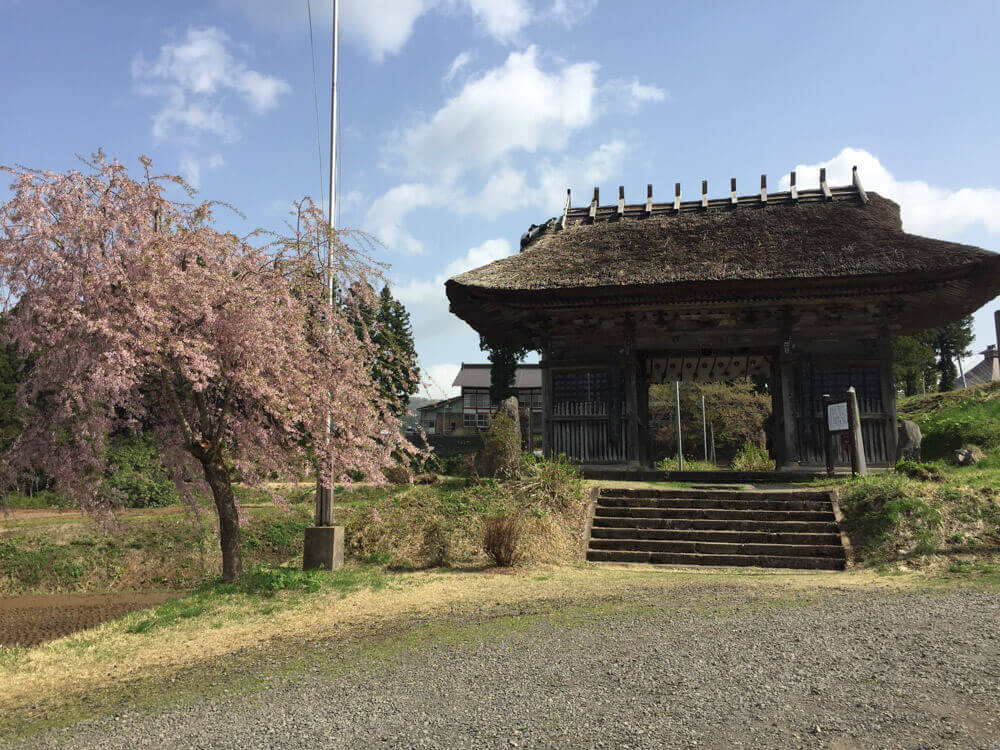
| Day One | Day Two |
| Mt. Haguro > Mt. Gassan > Mt. Haguro | Mt. Haguro > Mt. Yudono > Mt. Haguro |
The other way to hike all three Dewa Sanzan is to do them separately. The second Dewa Sanzan itinerary is best suited for those with a car, casual hikers, and those with a little bit of extra time. Again, staying on Mt. Haguro puts you in a good location to visit the other two. From here, we recommend setting aside one day to do Mt. Gassan. This time, take the bus or drive to the 8th Station of Mt. Gassan (Gassan Hachigome), climb to the top, and come back the same way. The busses are only available on certain days (see the Dewa Sanzan Busses section below).
The path from the 8th Station of Mt. Gassan to the summit takes two to three hours one way. It also avoids the most difficult part of the climb between Mt. Gassan and Mt. Yudono where ladders and large boulders are likely to get in the way. However, this way you will still be able to take in a lot of Mt. Gassan.
Getting to Mt. Yudono from Mt. Haguro
If you haven’t already, climb Mt. Haguro, then spend an afternoon going to Mt. Yudono separately. There is a bus to and from Tsuruoka Station or Mt. Haguro and Mt. Yudono that costs ¥3,000 for one day's travel. Again, this bus only operates on certain days (see the Dewa Sanzan Busses section below). There is no one-way bus ticket to Mt. Yudono, although private taxis can be organised for ¥5,000. Enquire for more details.
The second Dewa Sanzan itinerary allows you to do much more if you have the time, or a car. We'd highly recommend checking out Dainichibo and Churenji Temples too. These temples are home to some of the Sokushinbutsu Buddha Mummies or Living Buddha. Tamugimata is a village nearby with Tamugiso, a 350-year-old folk house that is designed for breeding silkworms and making silk. Alternatively, it would also be possible to do Mt. Yudono on the way to or from Mt. Haguro if you are coming by car from inland Yamagata.
Authentic experiences on the Dewa Sanzan
For authentic experiences on the Dewa Sanzan, check out Megurun. Megurun is a locally-based company that provides ample opportunities for self-development including their flagship Yamabushido programs. Simply put, there is no better experience on the Dewa Sanzan than authentic training with the yamabushi.
Dewa Sanzan Weather

Typically in the Shonai region the summer is hot, and winter is cold. There aren't many days where the opposite is true. In saying that, there is one word to describe the weather on the Dewa Sanzan; unpredictable. As Mt. Gassan is a mountain that is nearly 2000m high, the weather at the top is often completely different to that at the bottom. It's not unusual for it to be a blistering hot day at the bottom, and have thunderstorms at the top. This only adds to the attraction of the mountain, however. Having rain at the top can be a great way to cool off from the summer heat, and likewise being able to see all around is another drawcard to the mountain.
Mt. Haguro weather, on the other hand, tends to be a bit more predictable owing to the mountain's altitude. The canopy of cedar trees gives some respite from the summer heat, while also allowing less rain or snow fall through. However, the copious amounts of snow are still going to reach the ground, including the five metres that settles on top of the Five Story Pagoda. All this is to say that when it comes to Dewa Sanzan weather, it pays to be prepared.
Gear to bring on a Dewa Sanzan Hike
So, what should you take on a hike of the Dewa Sanzan? Remember, always bring plenty of water with you, at least one litre per person. Dry foods and something for lunch are also important. On that note, sun protection such as sunglasses, a hat, and sunblock, is also a good idea. However, Mt. Gassan gets a lot of precipitation, so be sure to bring waterproof clothing. In addition, the mountain can get very cold all of a sudden, so warm clothing is a must.
Good quality footwear, such as proper hiking boots, are also essential. Yamabushi mountain monks on the Dewa Sanzan opt for white Jikatabi split-toed ninja-style shoes. Make sure you grab some with a thin sole, as this helps your feet grab onto the rocks, and get more in touch with nature; an important aspect of any hike on the Dewa Sanzan.
If you can, we recommend bringing long rope and a first aid kit. A Tsue stick like the ones the Yamabushi use can also support your back as you climb. Not only that, the sound it makes scares off snakes. Tsue sticks can be bought at many of the shops on the Dewa Sanzan. They are also available at the Ideha Cultural Memorial Museum near Zuishinmon. Hanging a bell from your belt or bag is also a good idea to scare off any bears or other animals that may be attracted. Bees, wasps, horseflies, and mosquitos are also active on the mountains so be sure to apply bug spray, and if possible we recommend bringing poison remover.
Lockers for a Dewa Sanzan Hike
Lockers for your belongings are available at the base of Mt. Haguro in the Ideha Cultural Memorial Museum. There are three medium lockers for ¥300, or four large lockers for ¥500. Make sure to be there within the museum opening hours; 9-4pm from April to November, and 9:30-3:30pm from December to March. The museum closes on Tuesday. For a ¥400 entrance fee, the museum is also a great place to check out the history and culture of the Dewa Sanzan. Alternatively, lockers are available in the waiting room of Tsuruoka Station. There are 24 small lockers for ¥300, or 12 big lockers for ¥600. Lockers are a good option for those staying near Tsuruoka Station, or with onward travel.
Dewa Sanzan Busses

READ MORE: The Ultimate Guide to Accessing the Dewa Sanzan
Staying on Mt. Haguro?
Information for busses between Tsuruoka Station and Mt. Haguro and Mt. Gassan can be found here. If you’re staying in a Shukubo, most likely you will want to stop somewhere before Haguro Zuishinmon. Daishinbo and Daishobo are closest to Sakura Koji. Saikan, on the other hand, is located at the top of Mt. Haguro, so it would be best to get off at Haguro Sancho.
Mt. Haguro or Tsuruoka Station to Mt. Gassan
In 2019, the bus to and from the 8th Station of Mt. Gassan and Mt. Haguro runs every day in July and August, and on selected dates in September (1st, 7th, 8th, 14th, 15th, 16th, 21st, 22nd, 23rd, 28th, 29th, basically weekends and public holidays on the 16th and 23rd). This bus costs ¥1,560 from the top of Mt. Haguro (Haguro Sancho on the timetable), but can also be caught from the Shukubo Village or the Zuishinmon gates at the base. It is an extra ¥1,180 to get back to Tsuruoka Station on this bus. Alternatively, the bus that runs straight from the 8th station of Mt. Gassan to Tsuruoka Station costs ¥2,060.
Conclusion
The Dewa Sanzan are an amazing place for a hike. Not only will you join generations upon generations of pilgrims to the three sacred peaks, you can also be 'reborn'. If you're going to hike the Dewa Sanzan, we hope the information and itineraries provided help. Keep in mind the climbing seasons, and the bus timetable, and make sure you prepare both mentally and physically. Don't hesitate to contact us about any questions either! Otherwise, we really hope you enjoy your time up in the mountains!
Timothy Bunting
Tim Bunting is a Dewa Sanzan Shrine Yamabushi with over 10 years' experience living beneath the three mystical peaks. He is a self-professed Dewa Sanzan nerd, and is currently working on the Yamabushido project and Dewa Sanzan Monzenmachi Project with Megurun Inc. His roles including assisting in Yamabushi trainings, translating, interpreting, and curating Dewasanzan.com.
Insider information and updates on
The Dewa Sanzan.
Subscribe to the Dewa Sanzan Tribe now.

